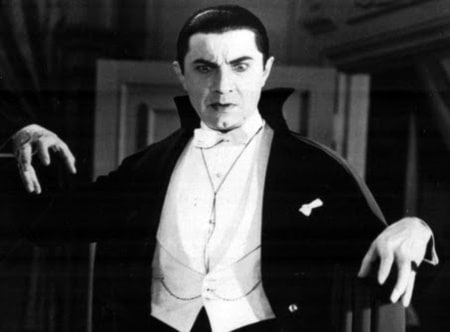Bram Stoker's 1897 novel Dracula was first translated to the screen in director F.W. Murnau's unauthorised German rendering Nosferatu, eine Symphonie des Grauens (1922). Nine years later, Universal Studios produced 1931's Dracula - the first official filmic adaptation of Stoker's novel, with the inimitable Bela Lugosi portraying the titular vampire. The golden era of Universal monster movies commenced with this 1931 production, and, although it was eclipsed by Frankenstein (released later in the same year), this film's importance in the annals of motion picture history is overwhelming. In fact, Dracula is a solid example of a film's reputation surpassing its content - as a standalone movie it's flawed, but as a phenomenon it's profoundly and eternally influential on our culture.

Despite being known as the first official film adaptation of Stoker's novel, Dracula is not directly based on this source material - instead, due to legal and financial mumbo jumbo, the movie is directly descended from a British stage production by Hamilton Deane that was in circulation during the mid-1920s. The story kicks off as a British real estate agent named Renfield (Frye) is travelling through the mountains of Transylvania to the decrepit and decaying Castle Dracula. His business is to organise the lease of a London abbey for the mysterious Count Dracula (Lugosi). During this visit, however, Renfield falls under the Count's spell. Meanwhile, once Dracula sets up residence in England, he begins to prey upon his neighbours - more specifically young woman. Enter Professor Abraham Van Helsing (Van Sloan) who believes in ancient legends of the living dead, and knows how to protect oneself from an involuntary blood donation.
To date, F.W. Murnau's Nosferatu remains the most artistic, chilling and atmospheric take on the Dracula story. Tod Browning's 1931 edition cannot equal the earlier movie in terms of effect or chills, but it does have its fair share of memorable moments. In retrospect, however, Browning was a subpar choice to helm the film. Though he developed a solid reputation as a director of silent pictures, Browning was clearly out of his element here - with a few exceptions, he lacked the basic skill required to craft a compelling horror movie. Later in 1931, James Whale's Frankenstein illuminated the weaknesses of Dracula - shots are at times too long, pacing is quite clumsy, editing is clunky, and dialogue is unconvincing. The special effects are cheesy as well - you can practically see the strings holding the bats in the air. Some of these flaws can be attributed to Browning's on-set demeanour: he was sullen due to the death of Lon Chaney, and reportedly acted unprofessionally throughout the shoot. In fact, Browning reportedly left the set on several occasions, leaving cinematographer Karl Freund to direct scenes. The most heartbreaking thing is the lack of chills, as the vampire attack scenes are simply not very effective.

Nevertheless, Browning did achieve a creepy atmosphere at times, with long periods of silence and stylised movement. Dracula's biggest asset, though, is the lighting and set design. The vast sets, particularly Dracula's castle, are spectacular, and convey a sense of size almost unequalled by set-work in more contemporary filmmaking. At times Dracula does play out like a silent film, with extended periods sans dialogue. No musical soundtrack was included for the film's theatrical release, as it was believed that (with sound being such a recent innovation in films) viewers would not accept hearing music in a scene unless there is a real source (like an orchestra that plays off-camera when Dracula is at the theatre). Interestingly, despite this being such a renowned vampire film, Dracula at no point displays his fangs. No vampire bite marks on the neck are ever visible, as well. It's also interesting to note that Universal Studios simultaneously produced a Spanish version of Dracula with a Spanish cast and crew - they used the same script and sets, and filmed at night after Browning's crew were done for the day.
Bela Lugosi's performance is another primary strength of Dracula. In fact, Lugosi's portrayal has become so famous and ingrained in popular culture that kids may quote him without knowing the origin of what they're saying (what kid hasn't said "I vant to suck your blood"?). While not as terrifying as Max Schreck (who portrayed the Dracula character in Nosferatu), Lugosi is excellent here, and this is by far his most famous role. In fact, when Lugosi died in 1956 he was buried wearing the silk cape he wore for this movie. Interestingly, before Lugosi got the part, the role was meant for Lon Chaney, but he died before filming.
Alongside Lugosi, Dwight Frye is chilling and engaging as Renfield. But outside of Frye and Lugosi, the acting is almost uniformly drab, with performances which would be better suited for a silent picture. David Manners is wooden as John Harker, and often appears to be standing around waiting for someone to direct him. Helen Chandler is bland as well, though Edward Van Sloan did a commendable job as Van Helsing.

Measured by contemporary standards, this 1931 rendering of Dracula is dated, hokey and at times monotonous, yet it still provides a few shivers. The film is never scary, mind you - it's just eerie, moody and filled with despair. It is ragged around the edges and suffers from serious technical problems, but these are not enough to prevent it from being appreciated. Essentially, Dracula is a self-recommending classic that must be seen by lovers of cinema.
6.9/10
 Login
Login